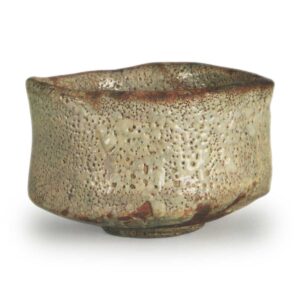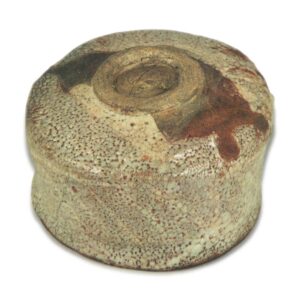

Height: 7.8 – 8.3 cm
Diameter: 12.4 – 13.3 cm
Foot diameter: 5.7 – 6.0 cm
Height: 0.6 cm
The white clay body is covered with a red clay slip, which is then scraped off to reveal the design. The piece is then glazed with a thick Shino glaze and fired, resulting in a dull, greyish-brown color, which is commonly referred to as “grey Shino”.
The name “grey Shino” is not an old term, but was given to this type of ware in the Showa period (1926-1989). In the past, it was simply called “Shino”, and some pieces were even marked “Oribe” on the box.
This teacup is made of a rough, eggshell-colored clay called ogusa, and apart from the foot and the surrounding area, it is covered in red clay on the inside and outside, making it one of the outstanding examples of nezumi-shino ware. The pattern is carved by scraping off the glaze with the tip of a spatula, revealing the white clay underneath, and then the Shino glaze is applied generously over the top. The pattern consists of a single horizontal line at the top and bottom, which are connected by a series of diagonal lines from the upper left to the lower right, but the glazed surface on one side is so thick that it is difficult to see, and at first glance it looks like a plain gray Shino.
The shape is a tight-bodied, upright shape, and the thick, bulky rim is slightly curved outwards. The waist is plump and full, and the thick, imposing foot supports the vessel. The rim has a gentle undulation, and the shape from above is almost a perfect circle, but it is slightly distorted.
The glaze is dark gray, with a slight reddish tinge, and there is a slight wrinkling of the glaze on the inside and outside. This is commonly referred to as “yuzu-hada” (yuzu skin), but the inside of the bowl is particularly wrinkled. There are many cracks on the surface, but they are not very noticeable because the surface is so badly cracked. The glaze is thin around the rim and where the fingers were used to apply the glaze, so it has burned reddish brown, revealing the red clay underneath, and the parts that were not glazed have also burned reddish brown.
There is an inscription in the foot ring. This is not a kiln mark, but a signature of the person who made this tea bowl. There are also examples with the same signature from Okaya, Ohira and Motoyashiki, so it is likely that tea masters from Kyoto visited various kilns and had them made.
Judging from the dignified style and glaze, I think this tea bowl is probably from Okaya, but I can’t say for sure which kiln it is from. However, I think it is definitely from Mino, and even if it is Mino, it is definitely from a kiln on the west side of the Toki River.
The box and provenance are both unknown.



